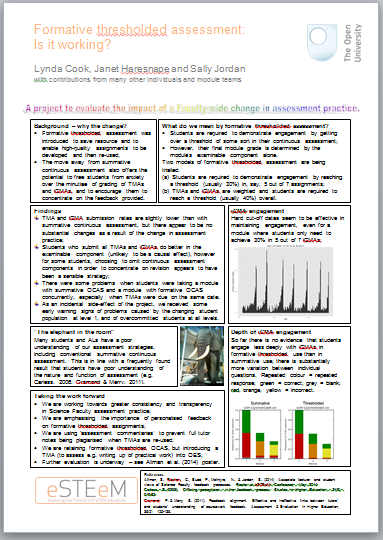I haven’t said much about the Open University Science Faculty’s move to formative thresholded assessment (first introduced here), or our evaluation of it, or our next steps. So much to catch up on…There is more on all aspects in the poster shown below, but you won’t be able to read the detail, so I’ll explain what we have found in a series of posts.
First of all a reminder of what we mean by formative thresholded assessment: Students are required to demonstrate engagement by getting over a threshold of some sort in their continuous assessment but their final module grade is determined by the module’s examinable component alone.
Two models of formative thresholded assessment are being trialled:
(a) Students are required to demonstrate engagement by reaching a threshold (usually 30%) in, say, 5 out of 7 assignments;
(b) Assignments are weighted and students are required to reach a threshold (usually 40%) overall.
And what of the findings? Here are some of the headlines:
- Assignment submission rates are slightly lower than with summative continuous assessment, but there appear to be no substantial changes as a result of the change in assessment practice;
- Students who submit all assignments do better in the examinable component (unlikely to be a causal effect); however for some students, choosing to omit continuous assessment components in order to concentrate on revision appears to have been a sensible strategy;
- There were some problems when students were taking a module with summative continuous assessment and a module with formative continuous assessment concurrently, especially when assignments were due on the same date.
However, to my mind, our most significant finding has been that many students and tutors have a poor understanding of our assessment strategies, including conventional summative continuous assessment. This is in line with a frequently found result that students have poor understanding of the nature and function of assessment – and we need to do something about it.

